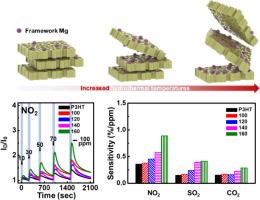Boosted organic gas sensing performance through the strong interaction between a two-dimensional magnesium silicate molecular sieve and target gas analytes
IF 13.2
1区 工程技术
Q1 ENGINEERING, CHEMICAL
引用次数: 0
Abstract
Conjugated polymers have great potential as sensing materials for portable sensor devices owing to their mechanical flexibility, cost-effectiveness, and light weight. However, they face challenges such as low sensitivity and poor stability under ambient conditions, owing to which their development lags behind that of inorganic-based gas sensors. Integrating functional nanomaterials into polymer semiconductors can enhance their gas sensitivity and stability. In this study, we present novel organic–inorganic hybrid gas sensors fabricated by blending zeolite nanocrystals with a conjugated polymer. The introduction of a magnesium-containing delaminated MCM tWenty-tWo (MWW) layer (Mg-DML-x, x = 100–160 °C) zeolite into the conjugated polymer matrix significantly improved gas-sensing performance while retaining high responsivity and rapid response rates. To explore the impact of the structural dimensions and framework of magnesium we adjusted the crystallization temperature of Mg-DML-x. The results show that the two-dimensional structure and Lewis basic framework magnesium in Mg-DML-x have a strong affinity for NO2 gas molecules, and this affinity becomes even stronger with increasing crystallization temperature of Mg-DML-x.

通过二维硅酸镁分子筛与目标气体分析物之间的强相互作用,提高了有机气体传感性能
共轭聚合物由于其机械灵活性、成本效益和重量轻等优点,在便携式传感器器件中具有很大的应用潜力。然而,它们面临着灵敏度低和环境条件下稳定性差等挑战,因此它们的发展滞后于无机气体传感器。将功能纳米材料集成到聚合物半导体中可以提高其气敏性和稳定性。在这项研究中,我们提出了一种新型的有机-无机杂化气体传感器,该传感器是由沸石纳米晶体与共轭聚合物混合制成的。在共轭聚合物基体中引入含镁分层MCM 22 (MWW)层(Mg-DML-x, x = 100-160 °C)沸石,显著提高了气敏性能,同时保持了高响应率和快速响应率。为了探究镁的结构尺寸和骨架对结晶温度的影响,我们调整了Mg-DML-x的结晶温度。结果表明,Mg-DML-x中的二维结构和Lewis基本框架镁对NO2气体分子具有很强的亲和力,并且随着Mg-DML-x结晶温度的升高,这种亲和力变得更强。
本文章由计算机程序翻译,如有差异,请以英文原文为准。
求助全文
约1分钟内获得全文
求助全文
来源期刊

Chemical Engineering Journal
工程技术-工程:化工
CiteScore
21.70
自引率
9.30%
发文量
6781
审稿时长
2.4 months
期刊介绍:
The Chemical Engineering Journal is an international research journal that invites contributions of original and novel fundamental research. It aims to provide an international platform for presenting original fundamental research, interpretative reviews, and discussions on new developments in chemical engineering. The journal welcomes papers that describe novel theory and its practical application, as well as those that demonstrate the transfer of techniques from other disciplines. It also welcomes reports on carefully conducted experimental work that is soundly interpreted. The main focus of the journal is on original and rigorous research results that have broad significance. The Catalysis section within the Chemical Engineering Journal focuses specifically on Experimental and Theoretical studies in the fields of heterogeneous catalysis, molecular catalysis, and biocatalysis. These studies have industrial impact on various sectors such as chemicals, energy, materials, foods, healthcare, and environmental protection.
 求助内容:
求助内容: 应助结果提醒方式:
应助结果提醒方式:


